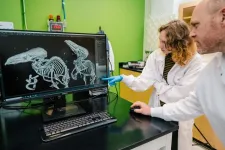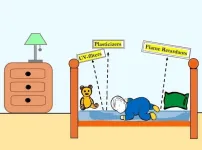(Press-News.org) Researchers at the VIB-UGent Center for Medical Biotechnology have discovered a promising strategy to improve treatment responses in multiple myeloma patients by blocking a protein that plays a key role in drug resistance. The study, published in Pharmacological Research, offers a potential new strategy to improve outcomes for patients whose disease has become less responsive to standard therapies.
Multiple myeloma (MM) is a type of blood cancer that affects the bone marrow. Patients are often treated with dexamethasone, a synthetic glucocorticoid frequently used in the clinic to regulate immune responses and slow cancer growth. However, as the disease progresses, many patients develop resistance to glucocorticoids.
The research team found that high levels of a protein, the chemokine receptor CCR1, are linked to worse outcomes in MM patients, particularly as the disease progresses. CCR1 is a receptor expressed on the surface of myeloma cells, through which the cells respond to chemical signals in the bone marrow environment and helps cancer cells to grow and survive.
Bert Luyckx, first author of the study, explains: “Our study shows that CCR1 is upregulated in MM patients with an unfavorable disease prognosis and plays a critical role in reducing glucocorticoid sensitivity in multiple myeloma cells. When we block CCR1 signaling, we see enhanced anti-cancer effects of dexamethasone in both lab models and patient samples.”
The team used a CCR1 inhibitor called BX471 and found that it helped to restore the effects of dexamethasone in cells that had started to become resistant. The drug combination pushed cancer cells towards programmed cell death and disrupted proteins involved in drug resistance.
“By targeting CCR1, we were able to partially reverse glucocorticoid resistance in multiple myeloma cells,” said Prof. Karolien De Bosscher. “This could offer new therapeutic opportunities for patients who no longer benefit from existing treatments.”
The findings suggest that CCR1 inhibitors could be used alongside current treatments to enhance their effectiveness. Further research is needed to explore how this approach can be applied in clinical settings.
END
Blocking chemokine receptor increases effectiveness of glucocorticoids in multiple myeloma treatment
Inhibiting CCR1 can reverse glucocorticoid resistance, offering a new strategy to improve myeloma treatment
2025-04-15
ELSE PRESS RELEASES FROM THIS DATE:
Amount of sunlight reaching Earth’s surface varies over decades, researchers report
2025-04-15
The sun may rise every morning, but the amount of sunlight reaching the Earth’s surface can substantially vary over decades, according to a perspectives article led by an international research team. The article, published on March 15 in Advances in Atmospheric Science, suggests that stages of “dimming” and “brightening” correspond with increased air pollution and implementation of clean energy solutions, respectively.
“The amount of sunlight — which is solar ...
Heart valve abnormality is associated with malignant arrhythmias
2025-04-15
People with a certain heart valve abnormality are at increased risk of severe heart rhythm disorders, even after successful valve surgery. This is according to a new study from Karolinska Institutet and Karolinska University Hospital in Sweden published in the European Heart Journal. The condition is more common in women and younger patients with valve disorder and can, in the worst case, lead to sudden cardiac arrest.
Mitral annular disjunction, MAD, is a heart abnormality in which the mitral valve attachment ‘slides’. In recent years, the condition has ...
Explainable AI for ship navigation raises trust, decreases human error
2025-04-15
The Titanic sunk 113 years ago on April 14-15, after hitting an iceberg, with human error likely causing the ship to stray into those dangerous waters. Today, autonomous systems built on artificial intelligence can help ships avoid such accidents, but could such a system explain to the captain why it was maneuvering a certain way?
That’s the idea behind explainable AI, which should help human actors trust autonomous systems more. Researchers from Osaka Metropolitan University’s Graduate School of Engineering have developed an explainable AI model for ships that quantifies the collision risk for all vessels ...
Study reveals erasing inequality could prevent hundreds of adverse births annually in major UK city
2025-04-15
In Birmingham, 43% of the population live in the most deprived 10% of neighborhoods in England. It is well known that deprivation can lead to adverse pregnancy outcomes, including low birth weight, premature birth, stillbirths, and neonatal mortality.
Now, researchers there examined the association between demographic, socioeconomic, and lifestyle factors and the risk of adverse birth outcomes in Birmingham and neighboring Solihull, an area much less affected by deprivation.
“Within the study population, there were significant differences in the odds of adverse birth outcomes and the risk factors of adverse birth outcomes by ethnicity ...
No “uncanny valley” effect in science-telling AI avatars
2025-04-15
If you’re among the 1.5 billion people worldwide using TikTok, you may have come across exceptional “testimonials” like Nikola Tesla or Marie Curie delivering short science-related messages that have garnered millions of views. This is just one of many examples where AI-generated avatars are used to communicate science — a strategy that might also have its drawbacks.
The generation of images and animations through artificial intelligence is a rapidly growing field, constantly improving in quality. Yet many avatars, though realistic, still present minor flaws — glitches, delays, inconsistent ...
New UNCG research shows southern shrews shrink in winter
2025-04-15
Newly published research from UNC Greensboro biology professor Dr. Bryan McLean and colleagues shows that the masked shrew, a small, mole-like mammal found in the Appalachian Mountains, shrinks its body and braincase to conserve energy during winter months. The study, published in the May 2025 issue of The American Naturalist, found that the masked shrew (Sorex cinereus) reduces its body mass by 13 percent in the colder months; the creature then grows larger in spring when conditions improve. In addition to a shrinking body, the team also found seasonal changes in the height of the creature’s ...
Children exposed to brain-harming chemicals while sleeping
2025-04-15
Babies and young children may breathe and absorb plasticizers called phthalates, flame retardants, and other harmful chemicals from their mattresses while they sleep, according to a pair of peer-reviewed studies published today from the University of Toronto in Environmental Science & Technology and Environmental Science & Technology Letters. These chemicals are linked to neurological and reproductive problems, asthma, hormone disruption, and cancer.
"Sleep is vital for brain development, ...
Emotions and levels of threat affect communities’ resilience during extreme events
2025-04-15
Hoboken, N.J., April 14, 2025 — Tightly connected communities tend to be more resilient when facing extreme events such as earthquakes, hurricanes, floods or wildfires, says Jose Ramirez-Marquez, who develops metrics to analyze, quantify and ultimately improve performance of urban systems.
Ramirez-Marquez, associate professor and division director of Enterprise Science and Engineering at Stevens, who grew up in the earthquake-prone Mexico City knows this first-hand. “Whenever there's an earthquake, a city-wide alarm goes off and everybody leaves wherever they are and stays in the middle of the street — that’s a prevention phase,” he says. ...
New CONSORT reporting guidelines published today in five medical journals
2025-04-14
Under embargo until 23:30 (UK), Monday April 14, 2025
An updated set of guidelines to improve transparency and clarity in the reporting of randomised controlled trials have been published today. The CONSORT (Consolidated Standards of Reporting Trials) 2025 statement provides a minimum set of essential items that should be included when reporting the results of randomised trials.
First published in 1996, the CONSORT guidelines saw additional updates in 2001 and 2010. Becoming the gold standard for reporting randomised trials, ...
Experts stress importance of vaccination amidst measles outbreaks
2025-04-14
Pediatric infectious diseases experts stress the importance of vaccination against measles, one of the most contagious viruses, which is once more spreading in the United States. In the article published in Pediatrics, they update pediatricians on this vaccine-preventable disease, which was previously declared non-endemic in the U.S.
“The most effective way to prevent measles is vaccination,” said lead author Caitlin Naureckas Li, MD MHQS, infectious diseases specialist at Ann & Robert H. Lurie Children’s Hospital of Chicago and Assistant Professor of Pediatrics at Northwestern University ...
LAST 30 PRESS RELEASES:
Statins significantly reduce mortality risk for adults with diabetes, regardless of cardiovascular risk
Brain immune cells may drive more damage in females than males with Alzheimer’s
Evidence-based recommendations empower clinicians to manage epilepsy in pregnancy
Fungus turns bark beetles’ defenses against them
There are new antivirals being tested for herpesviruses. Scientists now know how they work
CDI scientist, colleagues author review of global burden of fungus Candida auris
How does stroke influence speech comprehension?
B cells transiently unlock their plasticity, risking lymphoma development
Advanced AI dodel predicts spoken language outcomes in deaf children after cochlear implants
Multimodal imaging-based cerebral blood flow prediction model development in simulated microgravity
Accelerated streaming subgraph matching framework is faster, more robust, and scalable
Gestational diabetes rose every year in the US since 2016
OHSU researchers find breast cancer drug boosts leukemia treatment
Fear and medical misinformation regarding risk of progression or recurrence among patients with breast cancer
Glucagonlike peptide-1 receptor agonists and asthma risk in adolescents with obesity
Reviving dormant immunity: Millimeter waves reprogram the immunosuppressive microenvironment to potentiate immunotherapy without obvious side effects
Safety decision-making for autonomous vehicles integrating passenger physiological states by fNIRS
Fires could emit more air pollution than previously estimated
A new way to map how cells choose their fate
Numbers in our sights affect how we perceive space
SIMJ announces global collaborative book project in commemoration of its 75th anniversary
Air pollution exposure and birth weight
Obstructive sleep apnea risk and mental health conditions among older adults
How talking slows eye movements behind the wheel
The Ceramic Society of Japan’s Oxoate Ceramics Research Association launches new international book project
Heart-brain connection: international study reveals the role of the vagus nerve in keeping the heart young
Researchers identify Rb1 as a predictive biomarker for a new therapeutic strategy in some breast cancers
Survey reveals ethical gaps slowing AI adoption in pediatric surgery
Stimulant ADHD medications work differently than thought
AI overestimates how smart people are, according to HSE economists
[Press-News.org] Blocking chemokine receptor increases effectiveness of glucocorticoids in multiple myeloma treatmentInhibiting CCR1 can reverse glucocorticoid resistance, offering a new strategy to improve myeloma treatment



